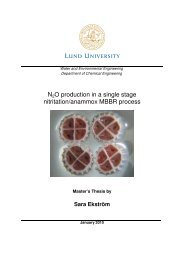Bättre EU-regler för en giftfri miljö - Kemikalieinspektionen
Bättre EU-regler för en giftfri miljö - Kemikalieinspektionen
Bättre EU-regler för en giftfri miljö - Kemikalieinspektionen
You also want an ePaper? Increase the reach of your titles
YUMPU automatically turns print PDFs into web optimized ePapers that Google loves.
substances which may be utilised subject to restrictions or conditions. Separate lists of<br />
substances that may be used exist for colours, preservatives and sun filters (UV filters). There<br />
are detailed requirem<strong>en</strong>ts governing labelling of the products with a requirem<strong>en</strong>t to list the<br />
ingredi<strong>en</strong>ts.<br />
The rules on cosmetics are aimed at protecting the consumers from health risks, but the rules<br />
do not address <strong>en</strong>vironm<strong>en</strong>tal aspects of the use of cosmetics. Environm<strong>en</strong>tal aspects may<br />
relate for example to the use of colours, preservatives and sun filters. We therefore propose<br />
that Swed<strong>en</strong> should work towards assessing how the <strong>en</strong>vironm<strong>en</strong>tal aspects could be dealt<br />
with through REACH, to <strong>en</strong>able more data to be produced on <strong>en</strong>vironm<strong>en</strong>tal risks regarding<br />
ingredi<strong>en</strong>ts of cosmetics.<br />
There are ext<strong>en</strong>sive detailed rules governing how substances may be used as cosmetic<br />
ingredi<strong>en</strong>ts, but certain rules on substances are based on outdated knowledge about health<br />
risks. Swed<strong>en</strong> should propose that <strong>EU</strong> rules are adopted which establish the regular<br />
reassessm<strong>en</strong>t of the safety of substances in <strong>EU</strong>’s Cosmetics Regulation.<br />
The use of s<strong>en</strong>sitising substances in cosmetics should be further restricted. There is also a<br />
need for a list of approved substances in hair-colouring products and further work on<br />
<strong>en</strong>docrine-disrupting substances.<br />
Rules governing chemicals in articles (Chapter 7.1 – 7.7)<br />
<strong>EU</strong> rules with regard to chemicals in articles are complex and difficult to p<strong>en</strong>etrate. The<br />
g<strong>en</strong>eral rules on chemicals (REACH) are also of significance for articles. The Product Safety<br />
Directive is applicable with regard to health risks from chemicals in articles. The Ecodesign<br />
Directive has so far be<strong>en</strong> focused on <strong>en</strong>ergy effici<strong>en</strong>cy but may in the future, to a greater<br />
ext<strong>en</strong>t, also regulate other design parameters such as chemicals. Moreover, there exist a large<br />
number of regulations that deal with special categories of articles, such as electronics, toys,<br />
packaging, vehicles etc.<br />
There is an on-going discussion about ext<strong>en</strong>ding the scope of the Eco-Design directive which,<br />
at pres<strong>en</strong>t, is only applied to <strong>en</strong>ergy-related articles. Although such an ext<strong>en</strong>sion may be<br />
justified in g<strong>en</strong>eral, the Directive is not particularly suitable for dealing with requirem<strong>en</strong>ts<br />
relating to the cont<strong>en</strong>t of dangerous chemicals. We consider that there is a need for<br />
requirem<strong>en</strong>ts on chemicals cont<strong>en</strong>t in respect of a number of categories of articles, which<br />
should be regulated by separate legal instrum<strong>en</strong>ts in the <strong>EU</strong>. This applies in particular if<br />
individuals are at risk of exposure, particularly childr<strong>en</strong>, or if rules are needed for managing<br />
waste from a material recycling perspective. Some such rules exist, but they need to be<br />
<strong>en</strong>hanced. Examples are electronics and toys. We propose that Swed<strong>en</strong> should press for rules<br />
at the <strong>EU</strong> level which impose uniform requirem<strong>en</strong>ts for chemicals in textiles, which can partly<br />
replace the criteria in ecolabelling schemes and voluntary restrictions lists which, in practice,<br />
have a very wide application in Swed<strong>en</strong>.<br />
Information requirem<strong>en</strong>ts regarding chemicals in articles (Chapter 7.8)<br />
A Swedish priority in work aimed at a non-toxic <strong>en</strong>vironm<strong>en</strong>t is to improve the information<br />
regarding hazardous substances contained in articles. A g<strong>en</strong>eral information requirem<strong>en</strong>t for<br />
substances of very high concern exists in REACH. We point out the need to supplem<strong>en</strong>t the<br />
candidate list in REACH, which forms the basis of the information requirem<strong>en</strong>t. Developm<strong>en</strong>t<br />
of information requirem<strong>en</strong>ts should otherwise be aimed at the separate <strong>EU</strong> directives dealing<br />
with articles. The global cooperation on chemicals (SAICM) has focused on the question of<br />
information and is important in this context.<br />
24















